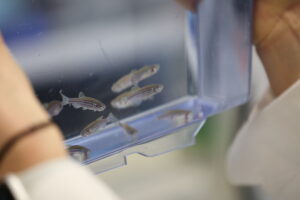Batten disease is a rare form of lysosomal storage disorder that primarily affects children and leads to progressive vision loss, intellectual delay, behavioural changes and premature death. Unfortunately, much of the disease remains poorly understood due to low patient numbers and a limited number of suitable in vivo models. In their latest publication, researchers from the Luxembourg Centre for Systems Biomedicine (LCSB), supported by its state-of-the-art Aquatic and Metabolomics Platforms, have developed a new zebrafish model that mimics key aspects of the human disease, paving the way for a deeper understanding of disease mechanisms as well as potential future diagnostic and treatment strategies.
Lysosomal storage disorders are rare genetic conditions in which specific digestion and/or recycling pathways of the metabolism are disrupted, leading to the accumulation of waste products that damage cells and tissues. A specific subtype of such a disease is juvenile neuronal ceroid lipofuscinosis, also known as Batten disease, which, in most cases, results from mutations in the CLN3 gene and causes a variety of neurological symptoms during childhood. As fewer than 1 in 25,000 children are born with the disease, clinical samples for study are rare, and many current animal models, such as mice and other mammals, do not develop the disease until adulthood. All of this contributes to slow research progress.
Researchers from LCSB’s Enzymology and Metabolism group, in collaboration with the centre’s Aquatic Platform, have now developed a zebrafish model of Batten disease. “We used the CRISPR-Cas9 technology to mutate the zebrafish equivalent of the gene causing the disease in humans. Zebrafish has become a widespread model in the field of neurological diseases, notably because of its fast development and transparency during larval stages, allowing to observe brain development under the microscope,” explains Dr Ursula Heins-Marroquin, lead author of the study. “While, at first, the Batten disease larvae did not show any noticeable physiological changes, in-depth behavioral analyses revealed subtle alterations, such as a higher baseline locomotive activity.”
In addition, metabolomic and lipidomic analyses performed in collaboration with the Environmental Cheminformatics group and the Metabolomics Platform at the LCSB revealed significant metabolic abnormalities in the model, even at very early stages of development. “Given the rather subtle neurological changes displayed by our zebrafish model, it was initially difficult to convince the community that it mirrors processes of the human disease. These doubts were swept away when we discovered that the fish larvae accumulate lipidic molecules that have recently emerged as hallmarks of human CLN3 Batten disease in independent parallel studies,’’ explains Prof. Carole Linster, head of the Enzymology and Metabolism research group. “This new model will serve as the missing middle ground between simple cell cultures and more resource- and cost-intensive mammalian models, while showing the important developmental aspects of the disease. It will allow to accelerate research on Batten disease, and more particularly on the underlying disease gene, CLN3, whose function still remains unknown.”
Using the new zebrafish model and deep metabolomic profiling, the team identified potential early biomarkers for Batten disease. As the disease disrupts the recycling of metabolic waste products, several metabolites from the glycerophosphodiester family were much more abundant in larvae with the CLN3 mutation than in healthy controls. “As an increase in these metabolites can also be detected in the blood of patients with CLN3-related Batten disease, this offers the prospect of early diagnosis before the typical neurological symptoms appear,” Prof. Linster adds. “Our new model may also facilitate drug screening to identify compounds that could slow or halt disease progression, a breakthrough that the 14’000 patients living with this still uncurable disease are eagerly waiting for.”
About animal research at the LCSB
Animal research plays an essential role in our understanding of health and disease and in the development of treatments for both animals and humans. At the LCSB, animal research is used to study diseases of the brain and the immune system. Wherever possible, we use non-animal methods such as cell cultures or computer models. However, these methods cannot fully mimic the complex interactions in the body. Therefore, a small proportion of experiments still require the use of animals. All animal testing is conducted in accordance with strict national and European legislation and ethical guidelines to ensure animal welfare. All animal research at the LCSB follows the replace, reduce and refine principle. Learn more here.
Reference
Ursula Heins-Marroquin, Randolph R. Sigh, Simon Perathoner, Floriane Gavotto, Carla Merino Ruiz, Myrto Patraskaki, Gemma Gomer-Giro, Felix Kleine Borgmann, Melanie Meyer, Anaïs Capentier, Marc O. Warmoes, Christian Jäger, Michel Mittelbronn, Jens C. Schwamborn, Maria Lorena Cardero-Maldonado, Alexander D. Crawford, Emma L. Schymanski, & Carole L. Linster, CLN3 deficiency leads to neurological and metabolic perturbation in early development, Life Science Alliance, January 2024, 7 (3) e202302057; DOI: 10.26508/lsa.202302057
Funding
This work was supported by donations from the ATOZ foundation, Mr. Norbert Becker, and through two grants by the Luxembourg National Research Fund (FNR) awarded to Prof. Carole L. Linster (C20/CM/14701042) and Prof. Emma Schymanski (A18/BM/12341006).
